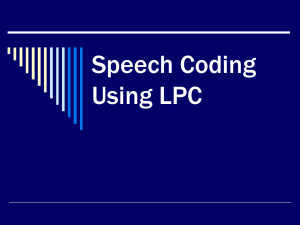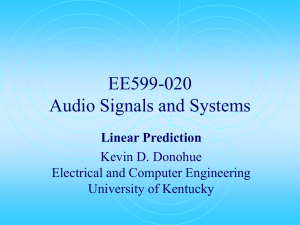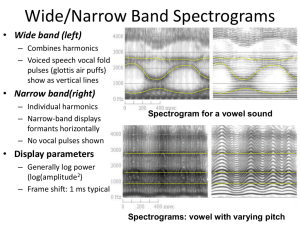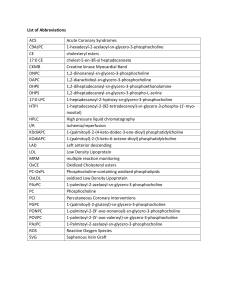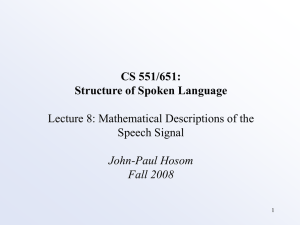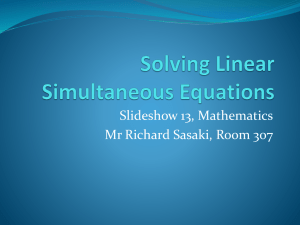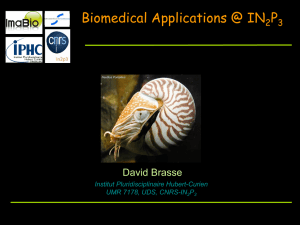5, -2, 0, 1, 2, 4, 3, 1
advertisement
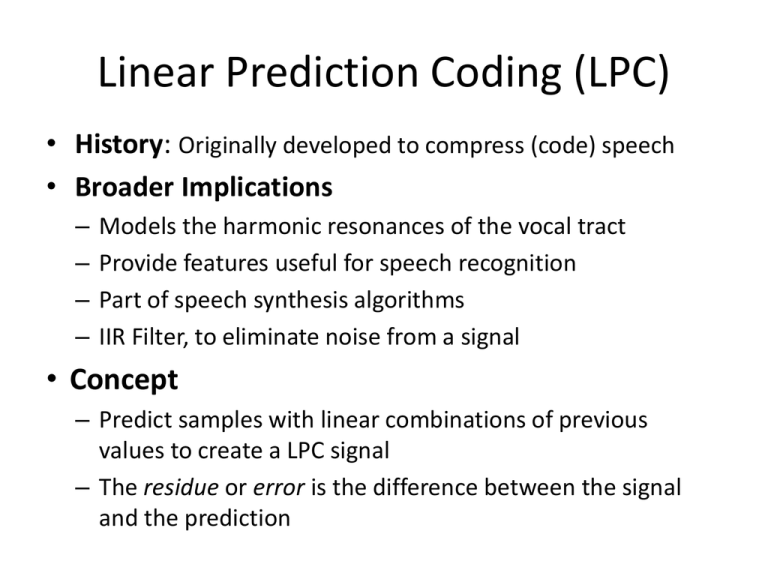
Linear Prediction Coding (LPC)
• History: Originally developed to compress (code) speech
• Broader Implications
–
–
–
–
Models the harmonic resonances of the vocal tract
Provide features useful for speech recognition
Part of speech synthesis algorithms
IIR Filter, to eliminate noise from a signal
• Concept
– Predict samples with linear combinations of previous
values to create a LPC signal
– The residue or error is the difference between the signal
and the prediction
LPC Calculations
• Predict the values of the next sample
Ŝ[n] = ∑ k=1,P ak s[n−k]
– P is the LPC order
– Accurate vocal tract model: P = sample rate*1000 + 2
– The LPC algorithm computes the ak coefficients
• The error signal (e[n]) is called the LPC residual
e[n]=s[n]− ŝ[n] = s[n]− ∑ k=1,p ak s[n−k]
• Goal: find ak coefficients that minimize the LPC residual
Linear Predictive Compression (LPC)
Concept
• For a frame of the signal,
find the optimal
coefficients, predicting the
next values using sets of
previous values
• Instead of outputting the
actual data, output the
residual, plus the
coefficients
• Less bits are needed, which
results in compression
Pseudo Code
WHILE not EOF
READ frame of signal
x = prediction(frame)
error = x – s[n]
WRITE LPC coefficients
WRITE error
Linear Algebra Background
• N linear independent equations; P unknowns
• If N<P, ∞ number of potential solutions
x + y = 5 // one equation, two unknowns
Solutions are along the line y = 5-x
• If N=P, there is at most one unique solution
x + y = 5 and x – y = 3, solution x=4, y=1
• If N>P, there are no solutions
No solutions for: x+y = 4, x – y = 3, 2x + 7 = 7
The best we can do is find the closes fit
Least Squares: minimize error
• First Approach: Linear algebra – find orthogonal
projections of vectors onto the best fit
• Second Approach: Calculus – Use derivative with
zero slope to find best fit
Solving n equations and n unknowns
Numerical Algorithms
• Gaussian Elimination
– Complexity: O(n3)
• Successive Iteration
– Complexity varies
• Cholskey Decomposition
– More efficient, still O(n3)
• Levenson-Durbin
– Complexity: O(n2)
– Symmetric Toeplitz
matrices
Definitions for any matrix, A
Transpose (AT): Replace all aij by aji
Symmetric: AT = A
Toeplitz: Descending diagonals to the right have equal values
Lower/Upper triangular: No non zero values above/below diagonal
Symmetric Toeplitz Matrices
Example
• Flipping rows and columns produces the same matrix
• Every diagonal to the right contains the same value
Levinson Durbin
Algorithm
or
Step 0
E0 = 1 [r0 Initial Value]
Step 1
E1 = -3 [ (1-k12)E0]
k1 = 2 [r1/E0]
Step 2
E2 = -8/3 [ (1-k22)E1]
k2 = 1/3 [(r2 – a11r1)/E1]
Step 3
E3 = -5/2 [(1-k32)E2
k3 = 1/4 [(r3 – a21r2 – a22r1)/E2]
Step 4
E4 = -12/5 [(1-k42) E3]
k4 = 1/5 [r4 – a31r3 – a32r2 – a33r1)/E3]
a11=2 [k1]
a21=4/3 [a11-k2a11]
a22=1/3[k2]
a31=5/4 [a21-k3a22]
a32=0 [a22-k3a21]
a33=1/4 [k3]
a41=6/5 [a31-k4a33]
a42=0 [a32-k4a32]
a43=0[a33-k4a31]
a44=1/5[k4]
Verify results by plugging a41, a42, a43, a44 back into the equations
6/5(1) + 0(2) + (0)3 + 1/5(4) = 2, 6/5(2) + 0(1) + 0(2) + 1/5(3) = 3
6/5(3) + 0(2) + 0(1) + 1/5(2) = 4, 6/5(4) + 0(3) + 0(2) + 1/5(1) = 5
Levinson-Durbin Pseudo Code
E0 = r 0
FOR step = 1 TO P
kstep = ri
FOR i = 1 TO step-1 THEN kstep -= ai-1,i * rstep-i
kstep /= Estep-1
Estep = (1 – k2step)Estep-1
astep,step = kstep-1
For i = 1 TO step-1 THEN astep,i = astep-1,I – kstep*astep-1, step-i
Note: ri are the row 1 matrix coefficients
Cholesky Decomposition
• Requirements:
– Symmetric (same matrix if flip rows and columns)
– Positive definite matrix
Matrix A is real positive definite if and only if for all x ≠ 0, xTAx > 0
• Solution
– Factor matrix A into: A = LLT where L is lower triangular
– Perform forward substitution to solve: L(LT[ak]) = [bk]
– Use the resulting vector, [xi], in the above step to perform a
backward substitution to solve for LT[ak] = [xi]
• Complexity
– Factoring step: O(n3/3)
– Forward and Backward substitution: O(n2)
Cholesky Factorization
Result:
Cholesky Factorization Pseudo Code
FOR k=1 TO n-1
lkk = a½kk
FOR j = k+1 TO n
ljk = ajk/ lkk
FOR j = k+1 TO n
FOR i = j TO n
aij = aij – lik ljk
lnn = ann
•
•
•
•
Column index: k
Row index: j
Elements of matrix A: aij
Elements of matrix L: l
Illustration: Linear Prediction
{1, 2, 3, 4, 5, 6, 7, 8, 9, 10, 11, 12, 13, 14, 15, 16}
Goal: Estimate yn using the three previous values
yn ≈ a1 yn-1 + a2 yn-2 + a3 yn-3
Three ak coefficients, Frame size of 16
Thirteen equations and three unknowns
LPC Basics
• Predict x[n] from x[n-1], … , x[n-P]
– en = yn - ∑k=1,P ak yn-k
– en is the error between the projection and the actual value
– The goal is to find the coefficients that produce the
smallest en value
• Concept
–
–
–
–
–
Square the error
Take the partial derivative with respect to each ak
Optimize (The minimum slope has a derivative of zero)
Result: P equations and P unknowns
Solve using either the Cholesky or Levinson-Durbin algorithms
LPC Derivation
• One linear prediction equation: en = yn - ∑k=1,P ak yn-k
Over a whole frame we have n equations and k unknowns
• Sum en over the entire frame: E = ∑n=0,N-1(yn - ∑k=1,P ak yn-k)
• Square the total error: E2 = ∑n=0,N-1 (yn - ∑k=1,P ak yn-k)2
• Partial derivative with respect to each aj; generates P equations (Ej)
Like a regular derivative treating only aj as a variable
2Ej = 2(∑n=0,N-1 (yn - ∑k=1,P akyn-k)yn-j)
Calculus Chain Rule: if y = y(u(x)) then dy/dx = dy/du * du/dx
• Set each Ej to zero (zero derivative) to find the minimum P errors
for j = 1 to P then 0 = ∑n=0,N-1 (yn - ∑k=1,P akyn-k)yn-j (j indicates the equation)
• Rearrange terms: for each j of the P equations,
∑n=0,N-1 ynyn-j = ∑n=0,N-1∑k=1,Pakyn-kyn-j = ∑k=1,P∑n=1,Nakyn-kyn-j
• Yule Walker equations: IF φ(j,0)= ∑n=0,N-1 ynyn-j, THEN φ(j,0) = ∑k=1,Pakφ(j,k)
• Result: P equations and P unknowns (ak), one solution for the best prediction
LPC: the Covariance Method
• Result from previous: φ(j,k) = ∑k=1,P∑n=0,N-1yn-kyn-j
• Equation j: φ(j,0)=∑k=1,Pakφ(j,k)
•
•
•
•
Now we have P equations and P unknowns
Because φ(j,k) = φ(k,j), the matrix is symmetric
Solution requires O(n3) iterations (ex: Cholskey’s decomposition)
Why covariance? It’s not probabilistic, but the matrix looks similar
Covariance Example
Recall: φ(j,k) = ∑n=start,start+N-1 yn-kyn-j
Where equation j is: φ(j,0) = ∑k=1,Pakφ(j,k)
•
•
•
•
•
•
•
•
•
•
•
•
•
•
Signal: { … , 3, 2, -1, -3, -5, -2, 0, 1, 2, 4, 3, 1, 0, -1, -2, -4, -1, 0, 3, 1, 0, … }
Frame: {-5, -2, 0, 1, 2, 4, 3, 1}, Number of coefficients: 3
φ(1,1) = -3*-3 +-5*-5 + -2*-2 + 0*0 + 1*1 + 2*2 + 4*4 + 3*3 = 68
φ(2,1) = -1*-3 +-3*-5 + -5*-2 + -2*0 + 0*1 + 1*2 + 2*4 + 4*3 = 50
φ(3,1) = 2*-3 +-1*-5 + -3*-2 + -5*0 + -2*1 + 0*2 + 1*4 + 2*3 = 13
φ(1,2) = -3*-1 +-5*-3 + -2*-5 + 0*-2 + 1*0 + 2*1 + 4*2 + 3*4 = 50
φ(2,2) = -1*-1 +-3*-3 + -5*-5 + -2*-2 + 0*0 + 1*1 + 2*2 + 4*4 = 60
φ(3,2) = 2*-1 +-1*-3 + -3*-5 + -5*-2 + -2*0 + 0*1 + 1*2 + 2*4 = 36
φ(1,3) = -3*2 +-5*-1 + -2*-3 + 0*-5 + 1*-2 + 2*0 + 4*1 + 3*2 = 13
φ(2,3) = -1*2 +-3*-1 + -5*-3 + -2*-5 + 0*-2 + 1*0 + 2*1 + 4*2 = 36
φ(3,3) = 2*2 +-1*-1 + -3*-3 + -5*-5 + -2*-2 + 0*0 + 1*1 + 2*2 = 48
φ(1,0) = -3*-5 +-5*-2 + -2*0 + 0*1 + 1*2 + 2*4 + 4*3 + 3*1 = 50
φ(2,0) = -1*-5 +-3*-2 + -5*0 + -2*1 + 0*2 + 1*4 + 2*3 + 4*1 = 23
φ(3,0) = 2*-5 +-1*-2 + -3*0 + -5*1 + -2*2 + 0*4 + 1*3 + 2*1 = -12
Auto-Correlation Method
•
•
•
•
Assume: all signal values outside of the frame (0<j<N-1) assumed zero
Correlate from -∞ to ∞ (most values are 0)
The LPC formula for φ becomes: φ(j,k)=∑n=0,N-1-(j-k) ynyn+(j-k)=R(j-k)
The Matrix is now in the Toplitz format
– The Levinson Durbin algorithm applies
– Implementation complexity: O(n2)
Auto Correlation
Example
Recall: φ(j,k)=∑n=0,N-1-(j-k) ynyn+(j-k)=R(j-k)
Where equation j is: R(j) = ∑k=1,P R(j-k)ak
• Signal: {…, 3, 2, -1, -3, -5, -2, 0, 1, 2, 4, 3, 1, 0, -1, -2, -4, -1, 0, 3, 1, 0, …}
• Frame: {-5, -2, 0, 1, 2, 4, 3, 1}, Number of coefficients: 3
•
•
•
•
R(0) = -5*-5 + -2*-2 + 0*0 + 1*1 + 2*2 + 4*4 + 3*3 + 1*1 = 60
R(1) = -5*-2 + -2*0 + 0*1 + 1*2 + 2*4 + 4*3 + 3*1 = 35
R(2) = -5*0 + -2*1 + 0*2 + 1*4 + 2*3 + 4*1 = 12
R(3) = -5*1 + -2*2 + 0*4 + 1*3 + 2*1 = -4
LPC Transfer Function
• Predict the values of the next sample
Ŝ[n] = ∑ k=1,p ak s[n−k]
• The error signal (e[n]), is the LPC residual
e[n]=s[n]− ŝ[n] = s[n]− ∑ k=1,p ak s[n−k]
• Perform a Z-transform of both sides
E(z)=S(z)− ∑k=1,pak S(z)z−k
• Factor S(z)
E(z) = S(z)[ 1−∑k=1,p ak z−k ]=S(z)A(z)
• Compute the transfer function: S(z) = E(z)/A(z)
• Conclusion: LPC is an all pole IIR filter
Speech and the LPC model
• LPC all-pole IR filter: yn = Gxn - ∑k=1,N ak yn
– The residual models the glottal source
– The summation approximates the vocal tract harmonics
• Challenges (Problems in synthesis)
– The residual does not accurately model the source (glottis)
– The filter does not model radiation from the lips
– The filter does not account for nasal resonances
• Possible solutions
– Additional poles can somewhat increase the accuracy
• 1 pole pair for each 1k of sampling rate
• 2 more pairs can better estimate the source and lips
– Introduce zeroes into the model
– More robust analysis of the glottal source and lip radiation
Vocal Tract Tube Model
• Series of short uniform tubes
connected in series
– Each slice has a fixed area
– Add slices for the model to
become more continuous
• Analysis
– Using physics of gas flow through
pipes
– LPC turns out to be equivalent to
this model
– Equations exist to compute pipe
diameters using LPC coefficients
The LPC Spectrum
1. Perform a LPC analysis
2. Find the poles
3. Plot the spectrum around
the z-Plane unit circle
What do we find concerning the LPC spectrum?
1. Adding poles better matches speech up to about 18 for a 16k sampling rate
2. The peaks tend to be overly sharp (“spiky”) because small radius changes
greatly alters pole skirt widths
